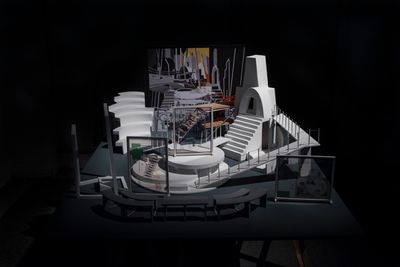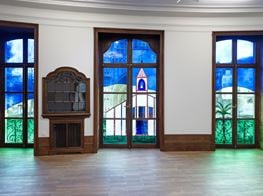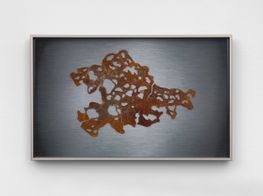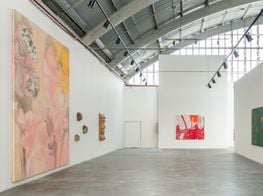'Polyphonic Worlds': Contour Biennale 8

Filipa César & Louis Henderson, Sunstone (2017) (production still). Single channel video, sound, colour. 7 min 30 sec. Courtesy the artists.
Polyphonic Worlds: Justice as Medium is the eighth edition of the Contour Biennale. It opened on 11 March 2017 (running until 21 May) with an ambitious exhibition and public programme curated by Natasha Ginwala and an all-female team of advisors including thinker Denise Ferreira da Silva, artist Judy Radul and writer Rachel O'Reilly, co-curator of public programmes. The Biennale references the Great Council, the historic medieval court established in Mechelen in the 15th century, and the city's tradition of polyphonic music as a way to reflect on how legal infrastructure, social justice and colonial power become formalised and exercised. In keeping, the Biennale has occupied six historical venues across Mechelen associated with architectures of power, including former homes of the Great Council, Aldermen's House and the Court of Savoy. Two contemporary spaces have also been inhabited: the Warehouse and Co-Working space outside the city centre, and contemporary arts centre The Garage.
Considering the current political climate—which includes the fragile legal status of vulnerable communities and refugees who exist at the fringes of national and international legal systems—the choice to make an exhibition addressing, among other issues, the way justice is administrated and the status of bodies before the law, could not have been more timely. How do we address historical injustices perpetuated by colonial power and neoliberal capitalism? Contour Biennale 8 grapples with such questions while considering the many ways art can not only be a form of protest, but can also play a role in developing speculative models to 'imagine the world anew', as Denise Ferreira da Silva put it.
Central to the Biennale's investigation is a consideration of justice as a medium for artistic intervention. Arguably, many biennales and exhibitions that promote themselves today as 'politically engaged' often fail, since proposed political claims do not enter into any meaningful relation with the reality of particular artistic practices and actions, thus only reinforcing the idea that art has no traction on social or political realities. By contrast, what renders Contour Biennale 8 credible in its political ambition is that while addressing the broader global picture, it allows for specific artistic positions and voices to emerge so as to not become fully absorbed into, or suffocated by a single homogenising ideological frame imposed by the curator. In other words, political analyses and reflections are expressed in and from the works themselves, with artists and collectives—of which there are 25, including Ho Tzu Nyen, Beatriz Santiago Muñoz, and Adelita Husni-Bey—attending to specific contexts and situations while drawing on larger political, social, and ethical issues in a manner that is rigorously embodied.
Of the works presented in The Garage, Ritu Sarin and Tenzing Sonam's multi-part series Burning Against the Dying of the Light (2015-17) stands out. Comprising several videos, documents and texts, as well as a large rotating Buddhist prayer wheel, the piece examines the radical practice of self-immolation that, since 2008, seems to have become the only viable and visible form of protest against the occupation of Tibet by China, and the systematic silencing and erasure of a people and their culture. For Contour Biennale 8, Sarin and Sonam have also produced a new video work, Drapchi Elegy (2017): a portrait of Namdol Lhamo, a Tibetan woman who was imprisoned in the early 1990s for peacefully demonstrating against the Chinese occupation, and who now lives in Brussels. Together, these two works show how the suppression of the conflict in Tibet has brought about more extreme forms of resistance.
The exhibition also considers the exploitation of indigenous lands of North Australia through the work of the Karrabing Film Collective. Formed in 2008 by a group of indigenous people of North Australia who use art as a form of political activism, the collective present the multimedia installation The Stealing C*nt$ (2015). The installation, shown in The House of the Great Salmon (formerly the home of the fish merchant's guild) consists of a three works produced for Contour Biennale 8 and a film, Windjarrameru The Stealing C*nt$. The film tells the story of two men who find a carton of beers but are then accused of stealing them by miners working illegally in sacred indigenous lands, which raises the question of who's stealing from whom. Evocative of Brechtian educational theatre, the film eloquently and unassumingly reflects on dispossession, the exploitation of natural resources, and the mutation of the ecosystem and survival of indigenous people, culture and lands. In a similarly poetic manner, artist Otobong Nkanga, whose work is shown in Alderman's House, reflects on the exploitation of raw mineral in the colonies by Germany and other European countries in her video Reflections of a Raw Green Crown (2015).
The relationships between theatre, the law and the formation of the legal subject is another important conceptual thread that runs through the exhibition. A particularly significant example here is the work of artist Rana Hamadeh, who, through a series of performances and text-based installations-as-stage-sets, has been exploring the genre of legal spectacle since 2011. Her thinking has by now become multi-layered, and her new project The Ten Murders of Josephine (working title), includes a multimedia installation, Sketch No. 1: On Proxy-bodies (2017), consisting of a series of music stands, texts, archival material, creating a maquette of what looks like a courtroom. Looking at the question of testimonial subjectivity, Hamadeh's work might be hard to access for the casual viewer. Yet, by giving enough time to appreciate its density and complexity, the reward is an experience of participating in an exercise in speculative thinking.
Semantic density likewise intensifies the sensual experience in Pedro Gómez-Egaña's breath-taking installation The Moon Will Teach You (2017). In the attic of the House of the Great Salmon, Gómez-Egaña has doubled the attic's beams and connected them, through a system of weights, to a printing machine. As the mechanic structure is set in motion, the building creaks as if the spirit of the building was stretching and about to wake up after a long sleep. The room eventually becomes completely dark and the crispy crackling sound comes to a halt. The body is immersed in a dark space of secrecy and mystery. The experience of the work is rendered even more enigmatic by the presence of fragments of text projected onto one wall; they are riddles, which, as the artist explains, were usually hidden in the manuscripts of music scores. Gómez-Egaña's work might be a metaphor for a type of knowledge that values the unspeakable and the unknown, which resonates with Sunstone (2017), a video and installation by artists Filipa César and Louis Henderson, presented in the Warehouse. In this work, the lighthouse is used as a metaphor for the Enlightenment's modern project, and the artist's call for 'a decolonisation of the lighthouse', or to paraphrase the writer and poet Édouard Glissant, the right to an opacity and obscurity that frustrates modern knowledge while opening other possibilities of knowing the world.
Indeed, this Biennale insists on the necessity to decolonise knowledges and practices. In Aldermen's House, for instance, there is the 'Evidence Room', where archival documents and fragments that have inspired the making of the exhibition—from a copy of an old medieval notation manuscript, to sketches and paintings that depict the violence of the Belgian colonisers in the Free Congo State—are collected together. Here, a gem of political avant-garde cinema, the short film J'ai huit ans (I Am Eight Years Old) (1961), plays on an old TV in a corner of the room. This was a collaborative documentary realised, among others, by Afro-Caribbean psychiatrist and anticolonial thinker Frantz Fanon and filmmaker René Vautier. Fanon's de-colonial psychiatric practice, still very little known, drew on an understanding of psychiatry that intersects history, lived experience, philosophy, ethnology and psychoanalysis. Shot during the Algerian War of Independence, which took place from 1954 to 1962, the video is composed of a collection of drawings made by Algerian orphans at refugee camps in Tunisia, collected by Fanon himself as part of his clinical work with Algerian refugees. The film feels incredibly relevant to questions many have been grappling for some time now, such as how to heal the wound that the systematic misuse of power, white supremacy, misogyny, racism, capitalism and colonialism have inflicted to this world, and how to reimagine existence outside the master and slave dialectic.
Echoing such questions is The Dreams of Cynthia (2017), a docu-fiction by New Delhi-based artist Pallavi Paul. An imaginary character, Cynthia, follows the lives of two people: a trans artist and an executioner in a village in North India. In the video two images and realities overlap: beautifully dressed and walking through the street of the village, the artist talks about her trans life, her loves and breakups, while the executioner, of whom we often only hear the voice, recounts the tale of a botched execution. The lives of the two are bound together by a history of exploitation, violence and death—although transgender people in India (as well as in other parts of the world) have been granted rights, trans communities are still stigmatised and remain prey to acts of violence, without much support from the law.
Between a political documentary and work of fiction, then, The Dreams of Cynthia reads like a hymn to all those who struggle to find their place in societies that marginalise them; a dedication to those who endure and find poetry where there is desperation. Paul's work offers another entry point into the exhibition by addressing, with wit and sensitivity, questions of class and gender, and the absence of such questions when it comes to true judicial representation.
Polyphonic Worlds: Justice as Medium is a solid and rigorously researched exhibition. Some might argue that the content-driven nature of many of the works in the show risks overshadowing the sensual experience. However, there is something to be said of works that ask for a moment of sustained engagement from their viewers that lasts for more than five seconds in order to appreciate the layering, depth and complexity that constitutes their form and content. All in all, the exhibition is to be applauded for managing to strike a rather difficult balance between theoretical propositions and aesthetic concerns, weaving together the threads of the poetic, sensual and the political, so that they might be read in tandem. I hope to see more biennales like this in the future.—[O]

















































































































































































